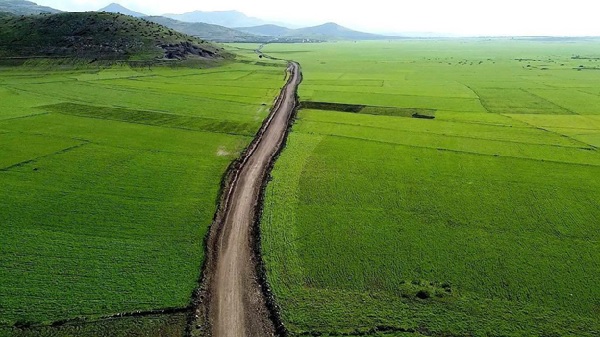
BY DANIEL ALEMAYEHU
It is reported that Ethiopia has not used its untapped resources though there are plenty to be exploited. Its natural and human resources could be used as a spring board to future economic development of the nation.
As it is the Ethiopian New Year, the country has registered tangible and fruitful achievements in the past fiscal year. Last year was not good for the people and government of Ethiopia with multiple challenges from in and out. The people have used those challenges as opportunity to stand in solidarity and work for unified goals.
From the achievements registered in the last fiscal year, agricultural outputs and success are on the top of the list. It is important to consider that those agricultural attainments have scored in some parts of the nation. As Tigray, Amhara and Afar regions are under security treats, farmers in these areas unable to exert their utmost effort on their farming. Most of them were participating in the war burst in the northern Ethiopia. The country has registered considerable amount of success in the summer wheat production.
On a panel discussion organized by a local media, responsible stakeholders have forwarded their opinions on summer wheat production. State Minister of Agriculture, Meles Mekonnen (PhD) said that based on the local demand and need; they have been working on wheat production. The nation has spent around 700 million USD every year in order to import wheat. On the other hand, the country has untapped natural resources along with human capital to produce it.
The nation has favorable agro- ecology that is suitable to substitute the imported wheat. Not only have that, the nation has wide untapped arable land, water resources, and hard-worker farmers who work tirelessly. Taking the aforementioned points into consideration, the ministry has been working in the past four years to save the unwanted expenses of hard currency for wheat importation, the State Minister added.
He further explained that in the first year, they have cultivated around 3 thousand hectares of land by irrigation for wheat production. In the second year, they have worked on 20 thousand hectares of land. In the first two years, those activities were implemented in Oromia region and through time they expanded it to neighboring states, Afar and Somali. In the third year, they have worked on 117 thousand hectares of land. This time, they have incorporated around nine regions. In the fourth year which is 2014, they have harvested around 670 thousand hectares of land by using both irrigation and summer wheat production.
In those consecutive years, they have increased their chances in terms of exerting their maximum potential. Besides, as to him, they have amplified their integration of professionals and institutions from federal to kebele structures. They have also developed their capacity regarding planning together and working on united goals. In addition, the farmers used to plough their lands once a year and do nothing in the rest of the year, but this time irrigation and fruit production become expanded. Therefore, the farmers have the chance to produce extra production in addition to their major ploughing season. This creates a favorable condition to farmers to use their time effectively. They can uplift their capacity along with the nation’s production and productivity.
By the same token, Agriculture Transformation Institute Director, Mandefro Nigussie (PhD) on his part said that they have achieved numerous successes. As to the director, cluster production has created a lot of opportunities for the farmers. The cluster system is important for the farmers to get the necessary equipment. When they collect their production, this system made things easy to get into the market. When farmers work in cluster, they can use mechanization and other farm machines easily.
When they go out to sell their products in cluster, it is easy to make a contact with big companies and wholesalers with better price. When a farmer goes to a market with its product, the farmer gets minimum price or benefit, but when farmers go to the market together, their power of negotiation will be higher, so will their benefits, the director noted. In the course of working together, farmers will have the chance to share their experiences. In addition, when they produce twice a year, their income will also be increased. “As a nation, we can get additional production. Above all, we can use our own products. Currently, with all those activities and experiences, we get 40 quintals of product per hectare on average,” the director added.
Moreover, Ethiopian Institute of Agricultural Research Director, Fetto Ismo (PhD) disclosed that it was the institute that firstly introduced and implemented the production of wheat through irrigation. It has been 20 – 30 years since the work started. Through this research and work, they have identified that there are different places that are suitable to grow wheat; however, multiple initiatives have been implemented on the practice, but none of them were sustained.
When the practice started, Ethiopian Institute of Agricultural Research took the lion’s share. The institute was responsible to conduct studies and other responsibilities. This time, the institute is working together with Agricultural Transformation Institute, Ministry of Agriculture, and all responsible stakeholders who are playing the major parts. The institute has selected suitable seeds for a particular place along with implementing agronomic practices in most of the areas, Fetto added.
It is important to remember that both summer and irrigation wheat production are widely implemented in Oromia Regional State. According to Oromia Agricultural Bureau Head, Abera Worku, wheat production through irrigation is implemented by the government itself. The initiative was started in order to cope up the post- Covid challenges. In Oromia, the region has harvested wheat using the region’s potentials.
As a region, Abera said; “We have learnt a lot. In the past many years, farmers could harvest wheat in two different seasons. This time, the practice of producing wheat by irrigation creates the third season for the farmers. We have also got the knowledge that we can produce wheat if we create favorable environment to the practice.”
Regarding achieving the success, the region has implemented both cluster farming and mechanization which had played the highest role in the process. At this moment, farmers are acquitted with producing wheat by irrigation, and they want to use the cluster farming coupled with mechanization. To make this into reality, every stakeholder and professional were beside the farmers and support them in every courses, Abera stressed.
Likewise, Agricultural Economy Scholar, Demes Chanyalew (PhD) on his part said that the management was the source of both the failure and the success of the sector. The management is the source for the registered success. When the initiative was about to start, a team of expertise discussed on the possibilities of how to stop importing wheat. “We have also planned on how to substitute the imported wheat locally within 2 – 3 years, so we have started to implement. The work is exemplary” the scholar said.
On the other hand, Sasakawa Africa Association Country Director, Fantahun Mengistu (PhD) noted that the route they took and the success they registered were very invigorating. By their achievement, other countries are motivated. Many countries that are labeled as major producers of wheat do not have many means, but Ethiopia has a number of ways to produce wheat. It can use the rainy season or irrigation.
Besides, based on the study conducted in the past, Fantahun added, there are twelve African countries that can be highly profitable by wheat production, and Ethiopia is one of those countries.
Regarding 2015’s plan, State Minister Meles Mekonnen (PhD) said that they planned to cultivate one million hectares of land using irrigation in 2015. It is stated that they have produced 40 quintals of wheat on average so that they planned to generate 40 million quintals of wheat at the end of 2015.
Based on the area’s potential, as to the State Minister, every place will contribute its share. Though the practice was started in one region, they have planned to extend the number to nine. In this year, they plan to incorporate Gambella and Benishangul regions.
Meles further explained wheat production is cost- effective for Ethiopia. Therefore, in the current year, regions have selected 2.8 million hectares of land for wheat production, and 2.6 million hectares of land is covered by wheat seeds. In addition, around 1.6 million hectares of land out of 2.6 million is selected for intensive wheat cluster production. They also expect more arable lands in Bale and other places are cultivated for the same purpose. They will give special attention for cotton production in some parts of the country especially in Afar, added the State Minister.
Meles said in 2015, local consumption is estimated around 97 million quintals. Again, the plan is to produce more than 107 million quintals of wheat. This means, there will be around 10 million quintals surplus product. Exporting this, the country can generate around 390 million USD. In order to achieve the goals, commitment needs to be the driving engine. Working on the basis of market system must be the timely issue. Besides, it is essential to fight the challenges and misdeeds observed in the market.
Agriculture Transformation Institute Director, Mandefro Nigussie also stated that on top of providing enough products to meet the local wheat demand, this system has created many job opportunities for young Ethiopians.
The Ethiopian Herald September 15/2022




